by Eric Meier
Honorable mentions:
See also: The poster, Worldwide Woods, Ranked by Hardness, should be required reading for anyone enrolled in the school of wood nerdery. I have amassed over 500 wood species on a single poster, arranged into eight major geographic regions, with each wood sorted and ranked according to its Janka hardness. Each wood has been meticulously documented and photographed, listed with its Janka hardness value (in lbf) and geographic and global hardness rankings. Consider this: the venerable Red Oak (Quercus rubra) sits at only #33 in North America and #278 worldwide for hardness! Aspiring wood nerds be advised: your syllabus may be calling for Worldwide Woods as part of your next assignment!
The poster, Worldwide Woods, Ranked by Hardness, should be required reading for anyone enrolled in the school of wood nerdery. I have amassed over 500 wood species on a single poster, arranged into eight major geographic regions, with each wood sorted and ranked according to its Janka hardness. Each wood has been meticulously documented and photographed, listed with its Janka hardness value (in lbf) and geographic and global hardness rankings. Consider this: the venerable Red Oak (Quercus rubra) sits at only #33 in North America and #278 worldwide for hardness! Aspiring wood nerds be advised: your syllabus may be calling for Worldwide Woods as part of your next assignment!
|
|
||
 |
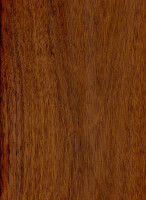 |
Mopane(Colophospermum mopane) Why you’ll love it: This wood has superb acoustic qualities (lots of potential here), it’s extremely dense, turns wonderfully, and it can have interesting color and grain patterns. Why you’ve never heard of it: It’s hard to find, usually only available in small chunks and turning blanks. Also, it’s quite expensive, and not too many people are prepared to spend a lot of money on a wood that they’ve never heard of, much less pronounce. Too bad, since it’s a stellar hardwood! |
|
|
||
 |
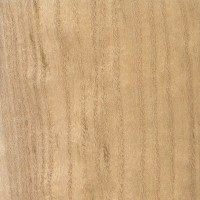 |
Paulownia(Paulownia tomentosa) Why you’ll love it: Among the absolute lightest woods available, but not as styrofoam-soft as Balsa. It is also one of the most stable woods with regard to humidity and has very low movement in service. It grows like a weed, and trees are frequently plantation grown. Why you’ve never heard of it: The Japanese seem to use it all up before anyone else can get their hands on it. It’s only fair, as the wood should simply go to the highest bidder, and Paulownia is prized in Japan and used for all sorts of things. |
|
|
||
 |
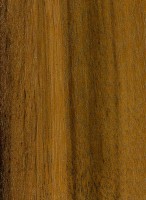 |
Greenheart(Chlorocardium rodiei) Why you’ll love it: Greenheart is a wood of extremes. Overall, it’s probably the strongest wood in the entire world (seriously), with off-the-charts MOE and MOR and crushing strength. It also has exceptional rot resistance and weathering characteristics, especially in marine environments. Why you’ve never heard of it: This stuff is just a pain to work with. It’s hard to glue, hard to saw, and it’s also hard to find. |
|
|
||
 |
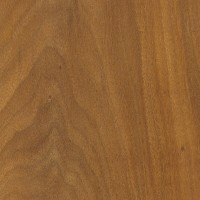 |
Chakte Viga(Caesalpinia platyloba) Why you’ll love it: So much to love… Chakte Viga has great acoustic/tonal qualities, it turns like a dream, it has a subtle iridescence that adds sophistication to any piece. But best of all, pieces with orangish or reddish coloration can be found—and the color actually lasts, which is more than can be said about some other *cough, Padauk, cough* woods. Why you’ve never heard of it: It also goes by the name Paela. It can be on the pricey side for a wood that’s unknown to many. |
|
|
||
 |
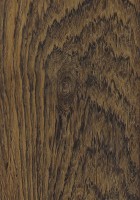 |
Burmese Blackwood(Dalbergia cultrata) Why you’ll love it: Is it shallow to love a pretty face? This wood is gorgeous… that’s about it. The grain pattern is totally unique and quite difficult to imitate or replace with another wood—I suppose the closest competition would be Pheasantwood. Why you’ve never heard of it: It’s seldom available, and when it is, it’s usually expensive. People probably figure it’s an ebony knockoff of some sort, but it’s an entirely different animal! |
|
|
||
 |
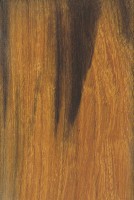 |
Desert Ironwood(Olneya tesota) Why you’ll love it: If you’re a knife-maker, you’ve probably heard of this wood before. The rest of the world doesn’t have a clue. This stuff is so dimensionally stable it’s almost scary. It just doesn’t move. It also has amazing colors, graining, and is superb for turning. Why you’ve never heard of it: The tree itself grows very small and crooked, so pieces are very limited, expensive, and small. This stuff is best used for those super-special small projects you’ve had in the back of your mind. |
|
|
||
 |
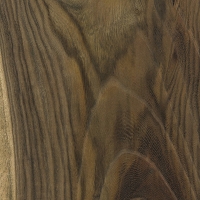 |
Pistachio(Pistacia vera) Why you’ll love it: Just look at it! It has everything going for it: interesting color with lots of variation, and stripes that would almost put a zebra to shame. Why you’ve never heard of it: People tend to like their Pistachio trees for, well, their pistachios. They don’t want to cut them down because you want some wood! This is going to cost you… |
|
|
||
 |
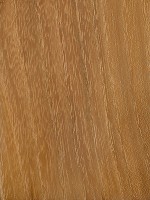 |
Black Locust(Robinia pseudoacacia) Why you’ll love it: Forget Ipe. Why do we need to go to a different continent to get a tough, durable wood when we’ve got one right in our own backyard? This stuff lasts and lasts, and unlike other domestics like Osage Orange, it’s actually available in usable lumber sizes for an economical price. Why you’ve never heard of it: I’m baffled as to why more people don’t know about and use Black Locust. Parts of Europe have caught on, and have already began plantations of Black Locust to supplant tropical hardwoods. |
|
|
||
 |
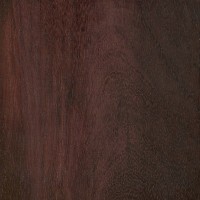 |
Katalox(Swartzia spp.) Why you’ll love it: Like Ebony, but not it’s prices? Then you’ll love Katalox. Some pieces can be just about a dark as true ebony, with just a hint of purple. Other pieces can be a more reddish brown with black streaks. So much depth in the Swartzia genus, there’s something for everyone here! Why you’ve never heard of it: It’s not too frequently imported, and many boards have a ridiculous amount of sapwood in them, so you have to hunt for the best pieces. Perhaps people think it’s too good to be true to find a dark ebony-like wood costing magnitudes less than the real deal. Believe it. |
|
|
||
 |
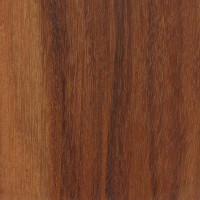 |
Macacauba(Platymiscium spp.) Why you’ll love it: This wood is uber-colorful, with many pieces having rich reds and oranges mixed in with darker brown and black veins of exquisiteness. Some woods are loved for their color, others are loved for their streaks and stripes. Macacauba has both. (And it’s inexpensive to boot.) Why you’ve never heard of it: This beautiful wood has languished under some of the absolute worst names on the planet. (I don’t have a clue how to pronounce Macacauba.) Other hideous names this wood has suffered with include: Macawood, Hormigo, and Coyote. Recently a marketing name has surfaced calling it “Orange Agate.” I hope something works for it: Cinderella needs to get some well-deserved attention. |
|
|
||
- Muninga (Padauk-relative with rock-solid stability)
- Boxwood (legendary for turning and carving)
- Laburnum (think of it as European Rosewood)
- Wamara (close relative to #2 ranked Katalox)
- Sycamore (break out of bland with some quartersawn stock)
- Texas Ebony (Ebony!? from Texas!? …kinda)
- Imbuia (looks like a burl, but it’s naturally that awesome)
- Sumac (olive green and striped, similar to Pistachio)
- Buckthorn (underneath the bark lies some fine-grained, pinkish/orange wood)
See also:
Are you an aspiring wood nerd?
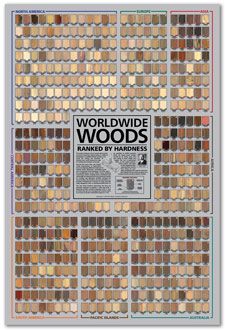 The poster, Worldwide Woods, Ranked by Hardness, should be required reading for anyone enrolled in the school of wood nerdery. I have amassed over 500 wood species on a single poster, arranged into eight major geographic regions, with each wood sorted and ranked according to its Janka hardness. Each wood has been meticulously documented and photographed, listed with its Janka hardness value (in lbf) and geographic and global hardness rankings. Consider this: the venerable Red Oak (Quercus rubra) sits at only #33 in North America and #278 worldwide for hardness! Aspiring wood nerds be advised: your syllabus may be calling for Worldwide Woods as part of your next assignment!
The poster, Worldwide Woods, Ranked by Hardness, should be required reading for anyone enrolled in the school of wood nerdery. I have amassed over 500 wood species on a single poster, arranged into eight major geographic regions, with each wood sorted and ranked according to its Janka hardness. Each wood has been meticulously documented and photographed, listed with its Janka hardness value (in lbf) and geographic and global hardness rankings. Consider this: the venerable Red Oak (Quercus rubra) sits at only #33 in North America and #278 worldwide for hardness! Aspiring wood nerds be advised: your syllabus may be calling for Worldwide Woods as part of your next assignment! 



This unidentified wood came from a large container of wood of various identified species from Laos where it was harvested. The sellers from Laos who are in direct contact with the harvester’s were clueless about this wood but thought it was good enough to add to the container. Sinks in water. I saw there are over well over 200 species there. Any idea’s?
How can I get a copy of the Hardest wood chart?
Sometimes the poster is out of stock or unavailable, but most of the time the most up to date availability can be found here:
https://www.wood-database.com/worldwide-woods/
I found a piece of wood from Malaysia, it’s been heat treated and that’s about all I know and can figure out. It’s extremely hard and the saw dust from it is very dark, it is a long straight grained wood. Any knowledge or information would be greatly appreciated.
Need to mention that Imbuia wood have a esplendit perfume
I am looking for a pretty wood to put on a tall ceiling of a great room. Pretty and fairly inexpensive; maybe thin to keep weight at a minimum.
What about Obeche? Light, strong and makes great solid body guitars.
This is a great list, and gives me some great ideas for my engagement ring box. The ring is silver and she loves red, so I had thought Padauk. But now I’m thinking Chakte Viga or Macacauba.
Eric… this “Orange Agate” is even more hideous as a marketing name than “Macacauba.” But I will tell you, once you understand the syllabic pronunciation for Macacauba, it’s spelling or pronounce you will never forget… BTW it’s pronounced, ma-ca-ca-uba… it’s a latin-ized (Spanish or Portuguese) version of a Indigenous name typical to Central and South America.
Personally for the reasons mentioned above, I would stick with the name Macacauba and Market the hell out of its beauty and simplicity of familiarity.
It is very easy to pronounce, may be because I also speak Persian, study little Arabic, used to speak little Turkish and Urdu, 50 years ago.
Just get Cacau, add an M at its beginning, then at the end add Cuba with an added A before U.
Then you get yourself Maakaakaa-uba
Can anyone tell me about Ndung from Sri Lanka. Must be a big tree, furniture timber. I think it sinks in water.
Do you happen to have a botanical name for Ndung? I can’t find any references to it.
I had a Paulownia Tree I planted in my back yard and it grew to 16 feet after a year from less than 3 feet. It is a wonderful tonewood with a bright sound and it is light. It can grow to 50 ft. in five years. You chop it down and it grows right back from the stump. It burns at 740 degrees Fahrenheit and photosynthesizes more CO2 than any other tree on the planet. Spain is planting them to reforest all the trees cut down that were needed to build ships in the early years of the Empire.… Read more »
It sounds like a great tree. It grows fast, probably stronger than pine.
Only other trees that I knew grow fast straight up are Poplar and the European Lumber Tree, here in San Ramon California,
I am going to read more on it. Plus, name is easy to pronounce. It is not hard like Macacauba, that I had to write one paragraph instruction : how to pronounce it.
How do I go about planting Burmese Blackwood & help it along, like on a farm level? I have 50 acres. I want to start a tree farm.
I had the same idea, I see you got no responses .let me know if you made progress.btwbi am from Pakistan and here they have started a local version of Burnese teak wood called Suhagna
mahogany (sweitania) vs. spanish cedar (cedro) window & door mfg. gulf coast region
or black locust (not used yet)
Recently used Mopane to turn a pen from, drilling was difficult as it burnt a lot because of the resin. Turned very well though, without a problem and came off in warm streams of the wood. Finishing was great and came out very shiny after wet sanding with paste wax, I put some carnauba over it but would prefer to use a harder finish in the future. Might order some more Mopane, fantastic wood with good working properties and good looking with an interesting grain.
This list has a lot of legumes (7/10 are Fabaceae). Mopane, Chakte Viga, Burmese Blackwood, Desert Ironwood, Black Locust, Katalox, and Macacauba are all legumes. They are early-succession generalists that can commensally fix nitrogen.
Pawlonia may be more readily available from a chandler, as it is used in lightweight boat building:
https://www.storerboatplans.com/faq-info-about-materials-and-methods/faq-paulownia-kirri-the-newest-lightweight-timber-for-boatbuilding/
I’d add Smoke tree, ‘Cotinus spp’ to the list of surprisingly beautiful woods, although it’s pretty soft and wants to tear out.
Rybacki–did you mean Horse Apple? That is what we called the ones in SW VA, USA, found mostly along creeks, often near willow trees, etc. Fruit looks like green brains ?
Horse Apple also goes by Osage Orange, and Bo’Darc (sp), but never heard it called Rybacki and google doesn’t help.
Bois de Arc, or wood of the bow, as it was a favorite of Native Americans for their Bow.
Osage, or Horse Apple in the Vernacular. And yes, the fruit looks like green brain.
Grandpa would not try to cut them but utilized them in place for his fences.
It is also known as Hedge Apple.
Amen to Mopane. I stumbled across some that had been used as an aquarium decoration, and found that it finishing like a dream. Work it with micromesh and it glows like polished stone, no oil or lacquer etc needed. THE most beautiful dark wood I have ever worked with, with no close second.
Didn’t (don’t) they make fishing rods from greenheart? Never seen it, but think I vaguely recollect it from Izaac Walton’s ‘The Complete Angler’.
Yes,Ive seen one, and practiced casting on the lawn; but never allowed to fish with it. Amazingly fine and light. It was composed of six tapering triangular lengths, glued and then bound with silk at intervals. You know the whipping that ties the eyes onto a rod; well the same effect was repeated at intervals to bind the six lengths of wood.
Search ‘Hardy’s greenheart trout rod’ gets several responses. But no close-ups.
I got a few small turning blanks of Black Locust setting in my shop right now that my father in law gave to me. Still not sure what I’m gonna do with it.
Desert ironwood was my favorite, so beautiful!
Macacaúba (pronounced Mah-cah-cah-OOH-bah) is indeed an ugly name! :)
Here in Brazil it has several different names, like Jacarandá-of-the-marsh, Jacarandá Piranga, Jandiá and variations of Macacaúba, like Red Macacaúba and Black Macacaúba. It also has some different names abroad, like Bastado (Nicarágua), Caoba (Equador), Koenatepie (Suriname), Nambar (Costa Rica), Trebol azul (Paraguai), Vencola (Venezuela).
These names are mostly originated within the indian tribes that discovered the trees.
Here we have an institute that provides info about these hardwoods of the south america. (the website is in portuguese, but it has very good information about these woods and their characteristics):
https://www.ipt.br/informacoes_madeiras/42.htm
I love black locust for its strong yellow fluorescence under UV-light (black light).
https://mimingcabico.site/wp-admin/post.php?post=84&action=edit
I just want to sign up for anything. Info. New use ,ect. Just love this site ,and the commentary. Lonely wood boat guy, think I just found my peeps
I love black locust for its strong yellow fluorescence under UV-light (black light).
mimingcabico.site
Here is an example of the Greenheart dressed up
I have about 25 Green Heart timber sleepers that I was gifted by my work place in Peterhead, Scotland. They Had been lying about the Base on the Scottish coast through the wind, rain and snow for about 15 years and looked ugly on the outside. I have plained one of them up and sanded it for a fire place mantle and it looks absolutely beautiful!! Hard on my tools but we’ll worth it. Im only 24 but I’m sure it will outlive me. First time iv ever seen or heard of this wood but seems to be quite similar… Read more »
Do you still have them ?
Both Imbuia and Kiaat (Muninga) are well known here in South Africa, Kiaat is especially popular for furniture at present with many stores marketing it as an alternative to Teak. As for Mopane, well that is better known as a worm (a delicacy… according to some!) than a wood.
Apparently the reason people in the USA don’t really use Black Locust is because an infestation of locust borers basically destroyed all the older, usable trees. Most US grown lumber has beetle holes in it, making it basically worthless.
Not in Kansas. I mill black locust and honey locust all the time. Great wood!
Black Locust is the thorn trees that farmers in the midwest planted for hedgerows and windbreaks. We used them for fence posts. I know of fences that were old when I was a kid in the 50s that are still just like they were 50 years ago.
Yep, good for 100 yrs
You are thinking of Osage Orange (hedge apple). Black locus grows tall with high branches and has a very rough and wrinkled bark. The issue with it is it will rot (carpenter ants love the stuff) and becomes a danger to any homes under it’s branches. FIL had a few trees removed recently. I have a few logs from them. Center of tree was mush. Could not find anyone interested in downing it to resaw. Arborer was not interested in doing anything with it but burning it. Great BTU’s btw.
lignum vitae and cumin